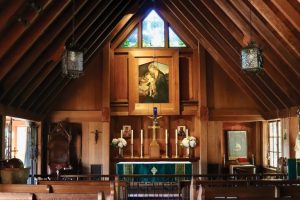Tucked into eight acres on Long Island’s Shinnecock Bay, St. Joseph’s Villa has been a place of respite and retreat since 1960, tended by the Sisters of St. Joseph of Brentwood. Today, the land is home to a new and unexpected development: not another building project, but a thriving kelp farm.
In recent decades, overdevelopment and a luxury tourism boom in the Hamptons have led to increased pollution and decreased water quality in Long Island’s bays. At the same time, the Villa has grown quieter, its use waning as the sisters age and local demographics change, meaning fewer people come on retreats.
Amid these changes, six women, all members of the Shinnecock Indian Nation, reached out to the sisters with a proposal: to start a regenerative kelp farm on the Villa’s shoreline property. Kelp aids marine ecosystems in multiple ways: It absorbs excess carbon dioxide, nitrogen, and phosphorus; it helps reduce acidity; and it provides food and habitat for an array of species.
Sister of St. Joseph Joan Gallagher says the answer to the proposal was obvious. “I just thought, this bay bears their peoples’ name,” she says. “How could we say no?”
Now entering its sixth planting season, the Shinnecock Kelp Farmers are cleansing local waters through a blend of ancestral tradition and cutting-edge science—and serving as a beacon of ecological renewal. And the sisters, meanwhile, are discovering how the land can serve the wider community, even as they prepare for a time when they will no longer be able to be its caretakers.
The Catholic Church owns more land than any private institution on Earth. If more Catholic communities and landowners followed the example of St. Joseph’s Villa, perhaps these properties could become sites of repair, relationship, and hope.
This is the work of Land Justice Futures, which helps Catholic sisters and other religious communities make choices about their land that align with their mission and serve the common good. For the past three years, we’ve accompanied more than 20 communities of sisters as they envision more creative and just futures for the lands, buildings, and properties they own.
This is a transitional time for church infrastructure in the United States. As Catholic orders age and as parishes close, we are approaching one of the largest transitions of religious landholdings in history. This could be an opportunity for the church to spearhead a once-in-a-millennium redirection of power, assets, and resources toward a more just and communal future.
The hidden history of land and law
In the 1400s, the Vatican issued three decrees that gave Christian rulers of European nations permission to “conquer, vanquish, capture, and subdue” non-Christian lands and people. These documents declared non-Christian land “empty” and therefore fair for the taking.
The so-called doctrine of discovery became the legal and moral backbone for centuries of colonization and eventually a cornerstone of U.S. property law. As recently as 2005, Ruth Bader Ginsburg cited it in a majority opinion, writing, “Under the ‘doctrine of discovery,’ fee title to the lands occupied by Indians when the colonists arrived became vested in . . . the discovering European nation.”
The Vatican officially repudiated the doctrine of discovery in 2023. Yet U.S. law still rests on the assumption that the pope’s 15th-century decree gives Christian nations ownership of lands already inhabited by Indigenous people. That violent fiction has real-life implications: By 1914, 84 percent of land on Earth was colonized by Christian Europe, which displaced, killed, and enslaved hundreds of millions of native people in the process.
Land justice in motion
Land justice asks us to face this history honestly and to ask how we can use the land in our care to start making amends. This is not a matter of simply rethinking estate and property planning; it’s a wholly different approach to property, which looks at land through the lens of history. This means rejecting the myths we tell ourselves about land ownership—myths that suggest that anyone powerful enough to seize land automatically owns it, or that it is morally acceptable for a few wealthy people to hold more property than they could ever possibly work or use.
In contrast to business-as-usual real estate, land justice is about resourcing sites of repair, reciprocity, and common care. And land justice can occur within all kinds of geographies, financial situations, property types, and legal realities.
One example of land justice is when a Methodist minister, after learning about the violent history of Black farmland loss, donated 80 acres of her farm to a Black-led farming cooperative. She kept 20 acres for her family, saying, “I’m not giving my land away—I’m trading it for the world’s best neighbors!”
In another example, a Minneapolis retreat center proactively sought out a collective of Black, queer artists and activists to inherit the center and cocreated a property transition plan with them. Together, they determined a below-market price that would cover the owners’ needs, an ample timeline for crowdfunding, and shared fundraising efforts.
And still another: A Presbyterian church in upstate New York, after dwindling to a dozen congregants, gifted their property to Sweetwater Cultural Center, a Ramapough-led place for educating people about and nourishing Indigenous lifeways.
Each of these communities shows how land can be a site of healing, justice, and relationship. There is no one-size-fits-all solution in the work of land justice—it involves a set of practices that each community can discern how to embody. Any Christian landowner—and anyone else motivated to work for reconciliation—can embrace its core principles: understanding the history of their land, getting creative with solutions, and prioritizing relationships.
Study and acknowledge history
Understanding the history of how our spaces were built and how we came to live on the lands where we live can lead to a richer understanding of relationship and what we owe one another.
For example, while researching their property’s history, the Franciscan Sisters of Little Falls discovered that the man who donated the congregation’s motherhouse to them in 1891 was also a speculator who profited from forcing Indigenous people in Minnesota from the area during the lumber boom. He worked with the government to trap tribes in debt in order to seize their land, clear-cutting hundreds of thousands of acres of valuable white pines in the process.
Having learned this, the sisters committed to supporting the Dakota people’s efforts for land recovery and restoration. They joined Dakota-led efforts for land recovery through prayer, fundraising, and community support. Months later, the two groups—perhaps unlikely allies—are now exploring the long-term return of one of the sisters’ properties to the Dakota.
Prepare to get creative
Traditional real estate transactions are designed to favor those with wealth and privilege. Communities that want their land to be used for reconciliation instead of using the sale for financial gain often need to find their own path—financially, legally, and relationally. The good news is that there are many creative options to figure this out.
For example, the John Woolman Quaker School gave its property to the Nisenan Tribe of Nevada City Rancheria. However, there was initially a tension between the school’s financial obligations and their commitment to justice. With the support of land justice practitioners, the group was able to structure a sale that covered Woolman’s costs while honoring the tribe’s vision. Together, they launched a national Quaker crowdfunding campaign that raised the needed funds. After a successful campaign, the tribe purchased the property in 2023.
Put relationships first
In Laudato Si’ (On Care for our Common Home), Pope Francis makes clear that hearing the “cry of the Earth and the cry of the poor” isn’t a two-step process—the two are inseparable. What if the church approached land discernment with a gospel-inspired commitment to those margins? After all, access to land has never been more critical—or more unequal. Ninety-eight percent of private land in the United States is owned by white people and institutions.
The history of the land is often the story of severed relationships. Land justice is about healing those broken ties between us and the land, with other people, and with God. Doing this work requires creativity and commitment, since it means finding the people most often excluded from the land market, taking the time to build trust with them, and asking what repair looks like from their perspective.
In practice, this might mean proactively searching for potential stewards, setting up flexible terms and timelines, and honoring the needs and vision of the partners. While the doctrine of discovery was designed to let a few privileged people claim the land exclusively for themselves, creating less space for others, land justice creates more space for right relationships.
Land justice isn’t something just for landowners to pursue, however. The call to heal and repair is for all of us. At a time when so much seems at risk—democracy, the Earth, our communities—perhaps the very instability of this moment could become a sacred opportunity. Together, we can work to redirect the flow of power and resources toward a more regenerative and communal future. Wherever we are, that’s where the work begins.
This article also appears in the November 2025 issue of U.S. Catholic (Vol. 90, No. 11, pages 23-25). Click here to subscribe to the magazine.
Image: Courtesy of Shinnecock Kelp Farmers















Add comment